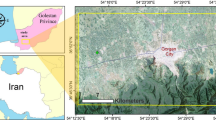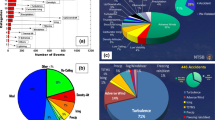Procedural questions related to the construction of mathematical models that establish a quantitative relationship between certain characteristics of the temperature field and the indicator of damping of the pulse electromagnetic field in a layer of the annual temperature fluctuations of built-up areas of the cryolithic zone of Yakutia are considered. Recommendations are given for practical application of the mathematical models based on an analysis of the errors that arise when calculating the temperature of frozen ground found with the use of the models.




Similar content being viewed by others
Notes
This, the upper part of permafrost, is important for construction. Here there occur processes of thermal interaction between the atmosphere and the lithosphere at different intensities over time and depth. The lower boundary of the layer, which exhibits null fluctuations of temperature over the annual cycle, is usually found at a depth of 10-15 m.
This includes the mean specific indicators and standard deviations of the rate of propagation (m/nsec) and damping of the amplitude of electromagnetic waves (dB/m).
Ground possessing a positive temperature which in the course of a lengthy geological time has not entered into a frozen state is referred to as unfrozen ground. Such ground should not be confused with thawed ground, which is formed as a result of thawing of frozen ground.
References
L. G. Neradovskii, A Study of the State and Properties of Frozen Ground and Cryopegs by Ground Penetrating Radar: Author’s Abstract of Dissertation for the Degree of Candidate in Technical Sciences, Yakutsk (2005).
L. G. Neradovskii, “Influence of temperature of permafrost ground on damping of electromagnetic energy,” Geofizika, No. 2, 57-67 (2009).
L. G. Neradovskii, “Certain petrophysical laws and models of built-up regions of the cryolithic zone of Yakutia,” in: Science and Technology: Proc. 29th Russian School [in Russian], Izd. RAN, Moscow (2009), pp. 122-134.
L. G. Neradovskii, “Influence of temperature field on damping of the electromagnetic field in built-up regions of the cryolithic zone of Yakutia,” Kriosfera Zemli, 14, No. 4, 56-65 (2010).
L. G. Neradovskii, “Procedural manual for the study of permafrost rock by means of dynamic ground penetrating radar,” Selected Works of the Russian School in Problems of Science and Technology [in Russian], Izd. RAN, Moscow (2009).
V. T. Balobaev et al., Manual for the Use of Semiconductor Thermistors for Geothermal Studies [in Russian], Melnikov Permafrost Institute, Yakutsk (1985).
A. P. Kulaichev, Methods and Means of Complex Data Analysis [in Russian], FORUM: INFRA-M, Moscow (2006).
A. D. Frolov, Electrical and Elastic Properties of Permafrost Rock and Ice [in Russian], ONTI PNTs RAN, Pushchino (1998).
S. V. Izyumov, S. V. Druchinin, and A. S. Voznesenkii, Theory and Methods of Ground Penetrating Radar: Manual for Students of Post-Secondary Educational Institutions [in Russian], Izd. MGGU, Moscow (2008).
Author information
Authors and Affiliations
Corresponding author
Additional information
Translated from Izmeritel’naya Tekhnika, No. 8, pp. 52-57, August, 2011.
Rights and permissions
About this article
Cite this article
Neradovskii, L.G. Calculation of the temperature of frozen ground on the basis of mathematical models of the temperature dependence of ground penetrating radar signals. Meas Tech 54, 931–938 (2011). https://doi.org/10.1007/s11018-011-9829-2
Received:
Published:
Issue Date:
DOI: https://doi.org/10.1007/s11018-011-9829-2




